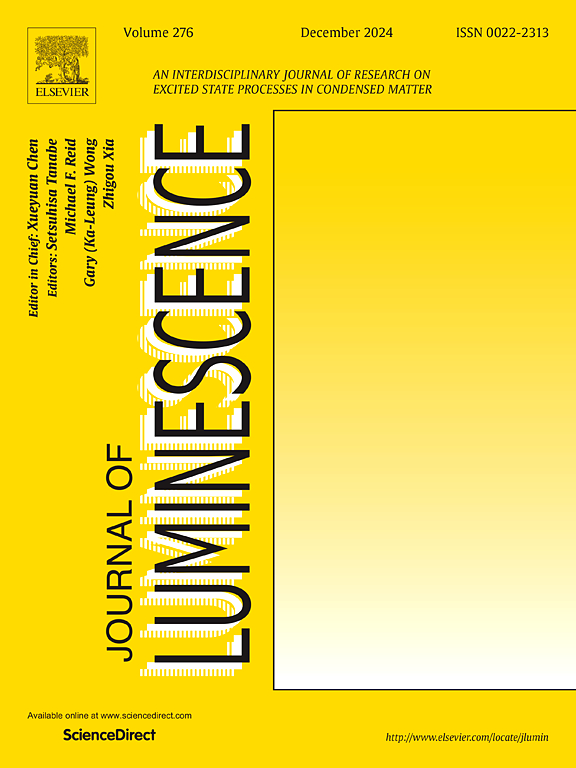Optical spectroscopy study of damage induced in nitrogen-doped 6H-SiC by neutron irradiation
IF 3.3
3区 物理与天体物理
Q2 OPTICS
引用次数: 0
Abstract
This study examines the effects of neutron irradiation on nitrogen-doped 6H-SiC single crystals (ND ≈ 3.0 × 1019 cm−3), focusing on defect formation, recovery, and optical properties. Neutron irradiation with a fluence of 1.27 × 1021 n/cm2 was followed by annealing from room temperature to 1650 °C. X-ray diffraction, UV–visible near-infrared absorption, and Raman spectroscopy were used to analyze changes in lattice structure, bandgap, and light absorption. Raman spectroscopy provided insights into chemical disorder and recovery mechanisms. The NCVSi configuration was identified as a key contributor to photoluminescence and defect energy levels. A four-stage recovery process was observed in Raman spectra, with varying contributions of Frenkel defects, interstitials, and vacancy types at different temperatures. Additionally, a novel defect-induced optical rotation effect was discovered due to radiation-mediated symmetry breaking, highlighting the impact of neutron irradiation on optical properties. This research offers a deeper understanding of defect recovery and optical effects in irradiated SiC materials and establishes 6H-SiC as a critical benchmark for radiation damage mechanisms in SiC polytypes.
中子辐照致氮掺杂6H-SiC损伤的光谱学研究
本文研究了中子辐照对氮掺杂6H-SiC单晶(ND≈3.0 × 1019 cm−3)的影响,重点研究了缺陷形成、恢复和光学性质。以1.27 × 1021 n/cm2辐照后,从室温退火至1650℃。利用x射线衍射、紫外-可见近红外吸收和拉曼光谱分析了晶格结构、带隙和光吸收的变化。拉曼光谱提供了对化学紊乱和恢复机制的见解。NCVSi结构被认为是光致发光和缺陷能级的关键因素。在拉曼光谱中观察到一个四阶段的恢复过程,在不同温度下,Frenkel缺陷、间隙和空位类型的贡献不同。此外,由于辐射介导的对称破缺,发现了一种新的缺陷引起的旋光效应,突出了中子辐照对光学性质的影响。该研究对辐照SiC材料的缺陷恢复和光效应有了更深入的了解,并建立了6H-SiC作为SiC多型辐射损伤机制的关键基准。
本文章由计算机程序翻译,如有差异,请以英文原文为准。
求助全文
约1分钟内获得全文
求助全文
来源期刊

Journal of Luminescence
物理-光学
CiteScore
6.70
自引率
13.90%
发文量
850
审稿时长
3.8 months
期刊介绍:
The purpose of the Journal of Luminescence is to provide a means of communication between scientists in different disciplines who share a common interest in the electronic excited states of molecular, ionic and covalent systems, whether crystalline, amorphous, or liquid.
We invite original papers and reviews on such subjects as: exciton and polariton dynamics, dynamics of localized excited states, energy and charge transport in ordered and disordered systems, radiative and non-radiative recombination, relaxation processes, vibronic interactions in electronic excited states, photochemistry in condensed systems, excited state resonance, double resonance, spin dynamics, selective excitation spectroscopy, hole burning, coherent processes in excited states, (e.g. coherent optical transients, photon echoes, transient gratings), multiphoton processes, optical bistability, photochromism, and new techniques for the study of excited states. This list is not intended to be exhaustive. Papers in the traditional areas of optical spectroscopy (absorption, MCD, luminescence, Raman scattering) are welcome. Papers on applications (phosphors, scintillators, electro- and cathodo-luminescence, radiography, bioimaging, solar energy, energy conversion, etc.) are also welcome if they present results of scientific, rather than only technological interest. However, papers containing purely theoretical results, not related to phenomena in the excited states, as well as papers using luminescence spectroscopy to perform routine analytical chemistry or biochemistry procedures, are outside the scope of the journal. Some exceptions will be possible at the discretion of the editors.
 求助内容:
求助内容: 应助结果提醒方式:
应助结果提醒方式:


